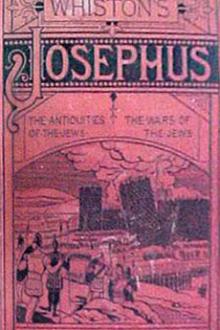The Wars of The Jews by Flavius Josephus (essential reading TXT) 📕

- Author: Flavius Josephus
- Performer: -
Book online «The Wars of The Jews by Flavius Josephus (essential reading TXT) 📕». Author Flavius Josephus
CHAPTER 4.
The Description Of Jerusalem.
1. The city of Jerusalem was fortified with three walls, on such parts as were not encompassed with unpassable valleys; for in such places it had but one wall. The city was built upon two hills, which are opposite to one another, and have a valley to divide them asunder; at which valley the corresponding rows of houses on both hills end. Of these hills, that which contains the upper city is much higher, and in length more direct. Accordingly, it was called the “Citadel,” by king David; he was the father of that Solomon who built this temple at the first; but it is by us called the “Upper Market-place.” But the other hill, which was called “Acra,” and sustains the lower city, is of the shape of a moon when she is horned; over against this there was a third hill, but naturally lower than Acra, and parted formerly from the other by a broad valley. However, in those times when the Asamoneans reigned, they filled up that valley with earth, and had a mind to join the city to the temple. They then took off part of the height of Acra, and reduced it to be of less elevation than it was before, that the temple might be superior to it. Now the Valley of the Cheesemongers, as it was called, and was that which we told you before distinguished the hill of the upper city from that of the lower, extended as far as Siloam; for that is the name of a fountain which hath sweet water in it, and this in great plenty also. But on the outsides, these hills are surrounded by deep valleys, and by reason of the precipices to them belonging on both sides they are every where unpassable.
2. Now, of these three walls, the old one was hard to be taken, both by reason of the valleys, and of that hill on which it was built, and which was above them. But besides that great advantage, as to the place where they were situated, it was also built very strong; because David and Solomon, and the following kings, were very zealous about this work. Now that wall began on the north, at the tower called “Hippicus,” and extended as far as the “Xistus,” a place so called, and then, joining to the council-house, ended at the west cloister of the temple. But if we go the other way westward, it began at the same place, and
extended through a place called “Bethso,” to the gate of the Essens; and after that it went southward, having its bending above the fountain Siloam, where it also bends again towards the east at Solomon’s pool, and reaches as far as a certain place which they called “Ophlas,” where it was joined to the eastern cloister of the temple. The second wall took its beginning from that gate which they called “Gennath,” which belonged to the first wall; it only encompassed the northern quarter of the city, and reached as far as the tower Antonia. The beginning of the third wall was at the tower Hippicus, whence it reached as far as the north quarter of the city, and the tower Psephinus, and then was so far extended till it came over against the monuments of Helena, which Helena was queen of Adiabene, the daughter of Izates; it then extended further to a great length, and passed by the sepulchral caverns of the kings, and bent again at the tower of the corner, at the monument which is called the “Monument of the Fuller,”
and joined to the old wall at the valley called the “Valley of Cedron.” It was Agrippa who encompassed the parts added to the old city with this wall, which had been all naked before; for as the city grew more populous, it gradually crept beyond its old limits, and those parts of it that stood northward of the temple, and joined that hill to the city, made it considerably larger, and occasioned that hill, which is in number the fourth, and is called “Bezetha,” to be inhabited also. It lies over against the tower Antonia, but is divided from it by a deep valley, which was dug on purpose, and that in order to hinder the foundations of the tower of Antonia from joining to this hill, and thereby affording an opportunity for getting to it with ease, and hindering the security that arose from its superior elevation; for which reason also that depth of the ditch made the elevation of the towers more remarkable. This new-built part of the city was called “Bezetha,”
in our language, which, if interpreted in the Grecian language, may be called “the New City.”
Since, therefore, its inhabitants stood in need of a covering, the father of the present king, and of the same name with him, Agrippa, began that wall we spoke of; but he left off building it when he had only laid the foundations, out of the fear he was in of Claudius Caesar, lest he should suspect that so strong a wall was built in order to make some
innovation in public affairs; for the city could no way have been taken if that wall had been finished in the manner it was begun; as its parts were connected together by stones twenty cubits long, and ten cubits broad, which could never have been either easily undermined by any iron tools, or shaken by any engines. The wall was, however, ten cubits wide, and it would probably have had a height greater than that, had not his zeal who began it been hindered from
exerting itself. After this, it was erected with great diligence by the Jews, as high as twenty cubits, above which it had battlements of two cubits, and turrets of three cubits altitude, insomuch that the entire altitude extended as far as twenty-five cubits.
3. Now the towers that were upon it were twenty cubits in breadth, and twenty cubits in height; they were square and solid, as was the wall itself, wherein the niceness of the joints, and the beauty of the stones, were no way inferior to those of the holy house itself. Above this solid altitude of the towers, which was twenty cubits, there were rooms of great magnificence, and over them upper rooms, and
cisterns to receive rain-water. They were many in number, and the steps by which you ascended up to them were every one broad: of these towers then the third wall had ninety, and the spaces between them were each two hundred cubits; but in the middle wall were forty towers, and the old wall was parted into sixty, while the whole compass of the city was thirty-three furlongs. Now the third wall was all of it wonderful; yet was the tower Psephinus elevated above it at the northwest corner, and there Titus pitched his own tent; for being seventy cubits high it both afforded a prospect of Arabia at sun-rising, as well as it did of the utmost limits of the Hebrew possessions at the sea westward.
Moreover, it was an octagon, and over against it was the tower Hipplicus, and hard by two others were erected by king Herod, in the old wall. These were for largeness, beauty, and strength beyond all that were in the habitable earth; for besides the magnanimity of his nature, and his magnificence towards the city on other occasions, he built these after such an extraordinary manner, to gratify his own private affections, and dedicated these towers to the memory of those three persons who had been the dearest to him, and from whom he named them. They were his brother, his friend, and his wife. This wife he had slain, out of his love [and jealousy], as we have already related; the other two he lost in war, as they were courageously fighting. Hippicus, so named from his friend, was square; its length and breadth were each twenty-five cubits, and its height thirty, and it had no vacuity in it. Over this solid building, which was composed of great stones united together, there was a reservoir twenty cubits deep, over which there was a house of two stories, whose height was twenty-five cubits, and divided into several parts; over which were battlements of two cubits, and turrets all round of three cubits high, insomuch that the entire height added together amounted to fourscore cubits. The second tower, which he named from his brother Phasaelus, had its
breadth and its height equal, each of them forty cubits; over which was its solid height of forty cubits; over which a cloister went round about, whose height was ten cubits, and it was covered from enemies by breast-works and bulwarks. There was also built over that cloister another tower, parted into magnificent rooms, and a place for bathing; so that this tower wanted nothing that might make it appear to be a
royal palace. It was also adorned with battlements and turrets, more than was the foregoing, and the entire altitude was about ninety cubits; the appearance of it resembled the tower of Pharus, which exhibited a fire to such as sailed to Alexandria, but was much larger than it in compass. This was now converted to a house, wherein Simon exercised his tyrannical authority. The third tower was Mariamne, for that was his queen’s name; it was solid as high as twenty cubits; its breadth and its length were twenty cubits, and were equal to each other; its upper buildings were more magnificent, and had greater variety, than the other towers had; for the king thought it most proper for him to adorn that which was denominated from his wife, better than those denominated from men, as those were built stronger than this that bore his wife’s name. The entire height of this tower was fifty cubits.
4. Now as these towers were so very tall, they appeared much taller by the place on which they stood; for that very old wall wherein they were was built on a high hill, and was itself a kind of elevation that was still thirty cubits taller; over which were the towers situated, and thereby were made much higher to appearance. The largeness also of the stones was wonderful; for they were not made of common small stones, nor of such large ones only as men could carry, but they were of white marble, cut out of the rock; each stone was twenty cubits in length, and ten in breadth, and five in depth. They were so exactly united to one another, that each tower looked like one entire rock of stone, so growing naturally, and afterward cut by the hand of the artificers into their present shape and corners; so little, or not at all, did their joints or connexion appear. low as these towers were themselves on the north side of the wall, the king had a palace inwardly thereto adjoined, which exceeds all my ability to describe it; for it was so very curious as to want no cost nor skill in its construction, but was entirely walled about to the height of thirty cubits, and was adorned with towers at equal distances, and with large bed-chambers, that would contain beds for a hundred
guests a-piece, in which the variety of the stones is not to be expressed; for a large quantity of those that were





Comments (0)